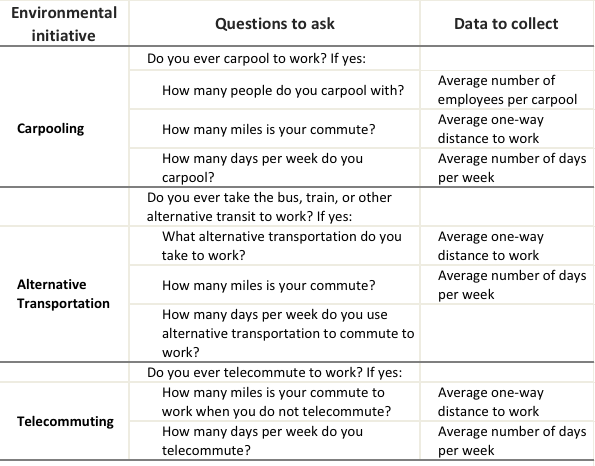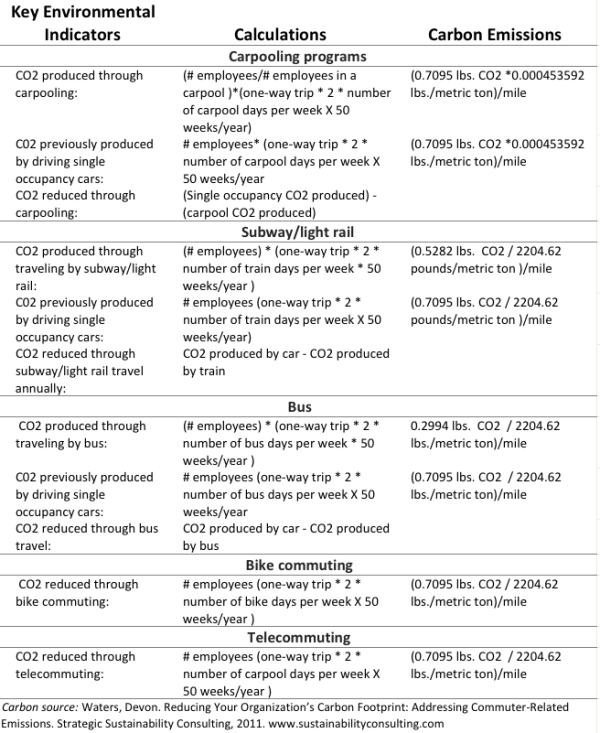 Employee-led volunteerism and environmental engagement has become central to companies’ CSR portfolios as employees form “green teams” to affect environmental impact in the workplace. Green teams offer on-the-ground expertise and enthusiasm to make significant steps toward sustainability. However, there are challenges to evaluating the global outcomes of decentralized efforts. In this first installment of our “How to Measure Your Environmental Impact at Work” series, we’ll be outlining ways employees can measure the impact of their commuting-related green initiatives.
Employee-led volunteerism and environmental engagement has become central to companies’ CSR portfolios as employees form “green teams” to affect environmental impact in the workplace. Green teams offer on-the-ground expertise and enthusiasm to make significant steps toward sustainability. However, there are challenges to evaluating the global outcomes of decentralized efforts. In this first installment of our “How to Measure Your Environmental Impact at Work” series, we’ll be outlining ways employees can measure the impact of their commuting-related green initiatives.
Strategies for more sustainable commuting
Programs intended to reduce environmental footprint of employees commuting to work commonly include the following components:
1. Carpooling
Carpooling can generate significant social value -- it reduces pollution, traffic congestion, builds relationships, and saves money. And for every gallon of gas you save through commuting, you also prevent the emission of more than 19 pounds of carbon dioxide. (source: EPA)
2. Alternative transportation
- Bus, train, and light rail: Many employers offer reduced bus and train passes and tax sheltered transit funds to promote mass transit use.
- Bike and walking commutes: In addition to bicycling commuter programs, LEED-certified office buildings include showers and bike storage to incentivize bike commuting.
3. Telecommuting
According to the nonprofit Telework Coalition, if the 41 million Americans with telework-compatible jobs worked from home once a week, we would reduce 423,000 tons of greenhouse gas emissions, the equivalent of taking 77,000 cars off the road for a year.
Tactics for measuring participation rates and impact
Sometimes implementing a sustainable commuting initiative feels like the easy part, as compared to tracking program participation and calculating its impact. Green teams can track the impact of programs intended to green employee commutes using the following methods:
Tracking Participation (Option 1): Leverage Exisiting HR Data
Leverage employee benefits enrollment to gather the environmental impact of commuting programs. In collaboration with your human resources department, determine the number of new employees taking advantage of alternative transportation incentives such as bus and train pass discounts, commuter sign-ups, and health-related biking benefits. Better yet, integrate simple questions about commute length into benefit enrollment forms, to help aid impact-measurement efforts (addressed below).
Tracking Participation (Option 2): 60 Second Surveys
If administrative data are unavailable, create an enticingly short survey to distribute among employees, both to identify the number of people taking advantage of sustainable commuting options and the nature of their participation. (Don’t worry about gathering data from 100% of participants – a sample can provide enough data to extrapolate the ballpark level of participation from across the entire employee pool.) Email employees a brief survey including the following questions, as relevant:

Calculating the environmental impact (Option 1): Manual calculations
Once you'd collected the above data from your employees, simple arithmetic generates your commuting initiative’s CO2 reductions. The sustainability firm Strategic Sustainability Consulting has a fantastic white paper, Reducing Your Organization’s Carbon Footprint: Addressing Commuter-Related Emissions, that calculates the carbon impact of workplace commuting. Below are the carbon calculations, using Strategic Sustainability's estimates, to measure the impact of your initiative:

Option 2: The Green Team ROI Tracker
Many publicly accessible sustainability calculators are designed for personal or small business use (you can find excellent calculators here, here, and here). However, these resources are often fragmented and single-issue focused, and not optimized for systematic business use. We set out to address this shortfall by creating the Green Team ROI Tracker, a composite set of calculators designed to address a broad range of potential green team projects.



